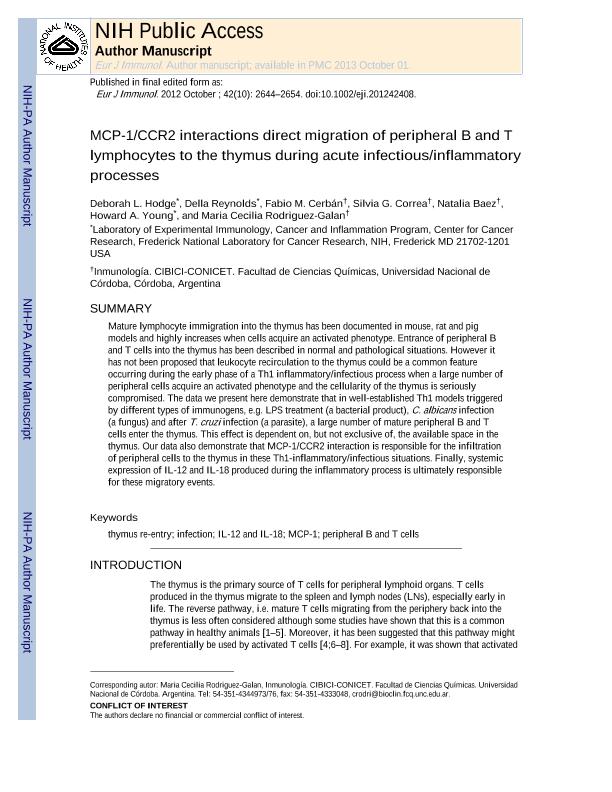Artículo
MCP-1/CCR2 interactions direct migration of peripheral B and T lymphocytes to the thymus during acute infectious/inflammatory processes
Hodge, Deborah L.; Reynolds, Della; Cerban, Fabio Marcelo ; Correa, Silvia Graciela
; Correa, Silvia Graciela ; Baez, Natalia Soledad
; Baez, Natalia Soledad ; Young, Howard A.; Rodriguez Galan, Maria Cecilia
; Young, Howard A.; Rodriguez Galan, Maria Cecilia
 ; Correa, Silvia Graciela
; Correa, Silvia Graciela ; Baez, Natalia Soledad
; Baez, Natalia Soledad ; Young, Howard A.; Rodriguez Galan, Maria Cecilia
; Young, Howard A.; Rodriguez Galan, Maria Cecilia
Fecha de publicación:
10/2012
Editorial:
Wiley VCH Verlag
Revista:
European Journal of Immunology
ISSN:
0014-2980
e-ISSN:
2090-0031
Idioma:
Inglés
Tipo de recurso:
Artículo publicado
Clasificación temática:
Resumen
Mature lymphocyte immigration into the thymus has been documented in mouse, rat, and pig models, and highly increases when cells acquire an activated phenotype. Entrance of peripheral B and T cells into the thymus has been described in healthy and pathological situations. However, it has not been proposed that leukocyte recirculation to the thymus could be a common feature occurring during the early phase of a Th1 inflammatory/infectious process when a large number of peripheral cells acquire an activated phenotype and the cellularity of the thymus is seriously compromised. The data we present here demonstrate that in well-established Th1 models triggered by different types of immunogens, for example, LPS treatment (a bacterial product), Candida albicans infection (a fungus), and after Trypanosoma cruzi infection (a parasite), a large number of mature peripheral B and T cells enter the thymus. This effect is dependent on, but not exclusive of, the available space in the thymus. Our data also demonstrate that MCP-1/CCR2 (where MCP-1 is monocyte chemoattractant protein-1) interaction is responsible for the infiltration of peripheral cells to the thymus in these Th1-inflammatory/infectious situations. Finally, systemic expression of IL-12 and IL-18 produced during the inflammatory process is ultimately responsible for these migratory events.
Palabras clave:
Il-12 And Il-18
,
Infection
,
Mcp-1
,
Peripheral B And T Cells
,
Thymus Reentry
Archivos asociados
Licencia
Identificadores
Colecciones
Articulos(CIBICI)
Articulos de CENTRO DE INV.EN BIOQUI.CLINICA E INMUNOLOGIA
Articulos de CENTRO DE INV.EN BIOQUI.CLINICA E INMUNOLOGIA
Citación
Hodge, Deborah L.; Reynolds, Della; Cerban, Fabio Marcelo; Correa, Silvia Graciela; Baez, Natalia Soledad; et al.; MCP-1/CCR2 interactions direct migration of peripheral B and T lymphocytes to the thymus during acute infectious/inflammatory processes; Wiley VCH Verlag; European Journal of Immunology; 42; 10; 10-2012; 2644-2654
Compartir
Altmétricas



